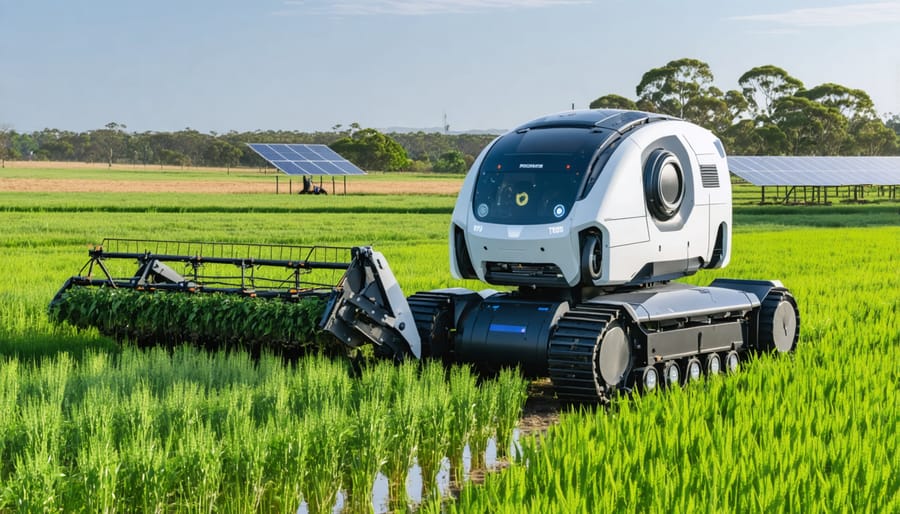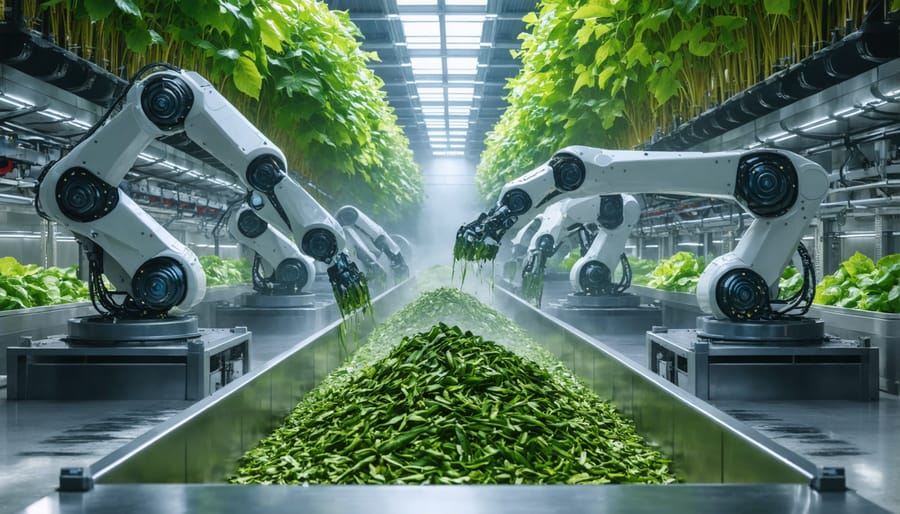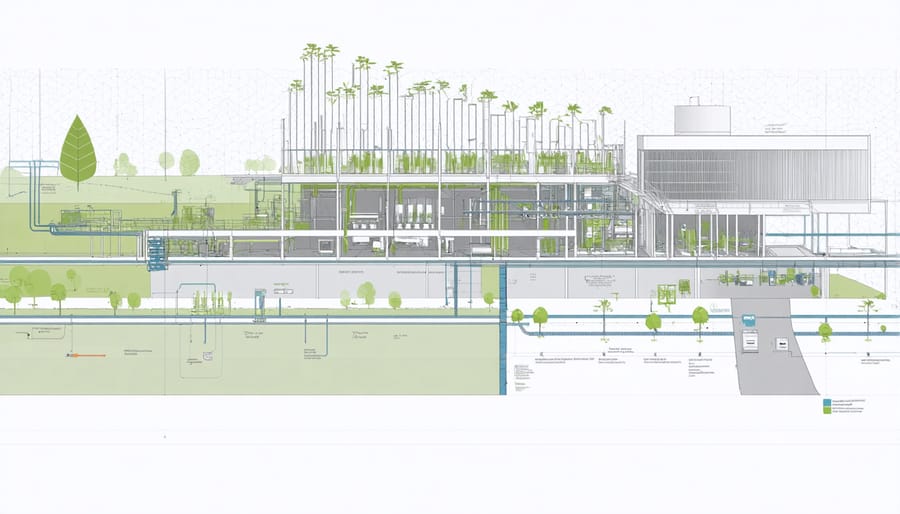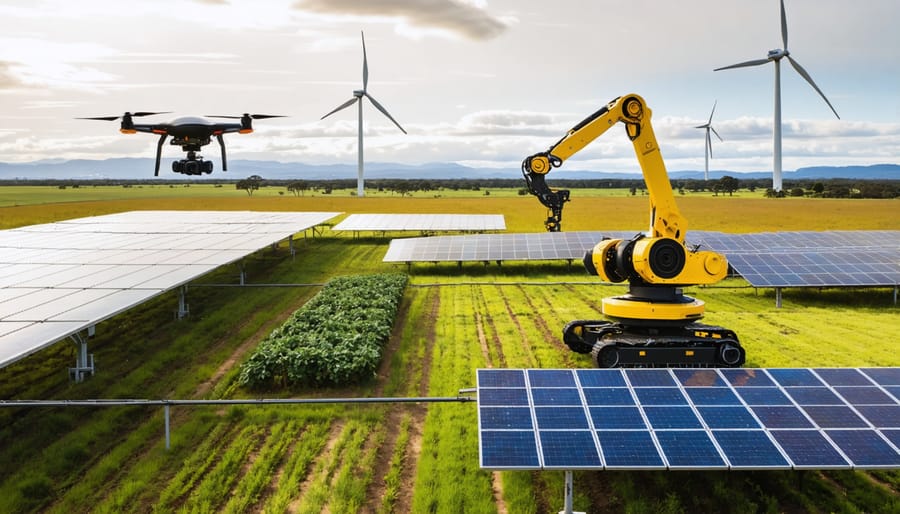Revolutionizing Australia’s sustainable energy landscape, robotic systems are transforming how we harvest, process, and optimize renewable energy resources. Autonomous drones now monitor vast solar arrays with precision accuracy, while sophisticated robots maintain wind turbines in conditions too dangerous for human workers. In biomass facilities across the country, AI-powered systems optimize combustion processes in real-time, increasing energy yield by up to 30% while reducing emissions.
This fusion of robotics and renewable energy represents more than just technological advancement—it’s a critical solution to our growing energy demands. Smart robots are revolutionizing maintenance schedules, predicting equipment failures before they occur, and ensuring maximum efficiency in energy generation. From automated solar panel cleaning systems that boost efficiency by 15% to robotic harvesters that collect and process biomass with unprecedented precision, these innovations are setting new standards in sustainable energy production.
The impact extends beyond mere automation. These systems are creating new jobs, reducing operational costs, and making renewable energy more accessible to communities across Australia. As we stand at the crossroads of energy innovation, robotic energy systems aren’t just supporting our renewable future—they’re actively building it.
Smart Harvesting: Robotic Systems in Biomass Collection
Precision Agriculture Robots
In the sun-drenched paddocks across Australia, a quiet revolution is taking place as autonomous robots transform how we manage our biomass crops. These cutting-edge machines are becoming invaluable partners in sustainable agriculture, combining precision technology with renewable energy production.
Smart robots equipped with advanced sensors navigate through crop rows, monitoring plant health, soil conditions, and moisture levels with unprecedented accuracy. These tireless workers operate on solar power, making them both environmentally friendly and cost-effective. In Queensland’s sugarcane fields, autonomous vehicles are already helping farmers optimize their harvesting schedules, ensuring maximum biomass yield while minimizing resource waste.
Aerial drones complement their ground-based counterparts, providing comprehensive field mapping and real-time crop analysis. These eye-in-the-sky robots can quickly identify areas requiring attention, from pest infestations to irrigation needs, allowing farmers to respond promptly and efficiently.
The integration of artificial intelligence enables these agricultural robots to learn and adapt to different conditions, making smart decisions about crop management. For instance, at the Bundaberg Smart Farm, robots automatically adjust irrigation patterns based on weather forecasts and soil moisture data, leading to water savings of up to 30%.
These precision agriculture robots are particularly valuable for energy crops like switchgrass and short-rotation woody crops, where optimal management is crucial for bioenergy production. By maximizing crop yields and reducing input costs, these robots are making biomass energy production more viable and sustainable than ever before.

Automated Sorting and Processing
In modern bioenergy facilities across Australia, AI-powered sorting systems and robotic processing units are revolutionising how we handle organic waste materials. These intelligent systems use advanced sensors and machine learning algorithms to identify, sort, and process different types of biomass with remarkable precision and efficiency.
At facilities like the Eastern Creek Resource Recovery Park in Sydney, robotic arms equipped with near-infrared sensors can distinguish between various types of organic materials in milliseconds. This technology ensures that only suitable biomass enters the energy production stream, significantly improving the quality of the final output while reducing contamination risks.
The automation process doesn’t stop at sorting. Smart robotic systems manage the entire processing chain, from size reduction and moisture content monitoring to optimal feed rate control. These systems work tirelessly 24/7, maintaining consistent quality standards that would be impossible to achieve manually.
A standout example is the Newcastle Bioenergy Plant, where automated processing units handle up to 50 tonnes of organic waste daily. The facility’s smart systems automatically adjust processing parameters based on real-time feedback, ensuring maximum energy yield while minimizing environmental impact.
The integration of robotics has led to a 40% increase in processing efficiency and a 25% reduction in operational costs across Australian bioenergy facilities. This technological advancement is making bioenergy production more viable and attractive to businesses looking to invest in sustainable energy solutions.
Energy-Efficient Robotics in Bioenergy Plants

Self-Monitoring Systems
Modern bioenergy facilities are increasingly relying on sophisticated AI-powered bioenergy systems that continuously monitor and optimize operations. These intelligent robots serve as tireless guardians of our renewable energy infrastructure, using advanced sensors and machine learning algorithms to detect potential issues before they become problems.
In facilities across Australia, self-monitoring robots patrol production areas, checking everything from biomass moisture levels to combustion efficiency. These smart machines use thermal imaging to identify hotspots, detect equipment wear, and ensure optimal performance of critical components. They’re particularly valuable in remote locations, where human monitoring might be challenging or cost-prohibitive.
What makes these systems truly remarkable is their ability to learn and adapt. As they gather data, they become more efficient at predicting maintenance needs and identifying patterns that human operators might miss. For instance, at a leading biomass facility in Queensland, monitoring robots have reduced unexpected downtime by 45% and increased overall system efficiency by 15%.
These robotic systems also play a crucial role in safety management. They can operate in hazardous environments, checking gas levels, temperature variations, and pressure readings without putting human workers at risk. When integrated with facility management systems, they provide real-time updates and automated responses to potential hazards.
The future of self-monitoring systems looks even more promising, with developments in swarm robotics allowing multiple units to work together, sharing data and coordinating responses. This collaborative approach ensures more comprehensive coverage and faster response times, making our renewable energy systems more reliable and efficient than ever before.
Energy Recovery Mechanisms
Modern robotic systems are becoming increasingly efficient through innovative energy recovery mechanisms that capture and repurpose what would otherwise be wasted energy. One of the most promising approaches is regenerative braking, similar to what’s used in electric vehicles. When robots slow down or stop, their motors act as generators, converting kinetic energy back into electrical energy that can be stored in batteries or capacitors for later use.
In Australia, mining companies are leading the way with automated systems that recover energy from descending loads in their operations. For instance, robotic cranes working in ore processing facilities capture potential energy as they lower heavy materials, reducing overall power consumption by up to 30%.
Another breakthrough is the development of elastic energy storage systems, inspired by nature’s own solutions. These systems use special springs and flexible materials to store energy from a robot’s movement, much like a kangaroo’s tendons store energy during hopping. When released, this stored energy helps power the next movement, significantly reducing the energy needed for repetitive tasks.
Heat recovery systems are also making waves in industrial robotics. Thermal energy generated by motors and actuators is captured through specialized heat exchangers and either converted back to electrical power or used for other processes in the facility. Some innovative Australian manufacturers have reported energy savings of up to 25% by implementing these heat recovery mechanisms in their robotic assembly lines.
These energy recovery solutions are particularly valuable in remote operations, where every bit of power saved means extended operating times and reduced need for backup power systems.
Real-World Success Stories
Queensland’s Smart Biomass Facility
Located in the heart of Queensland’s renewable energy corridor, the Smart Biomass Facility stands as one of Australia’s most advanced bioenergy innovation centers. This state-of-the-art facility showcases how robotics and automation are revolutionizing biomass energy production.
The facility’s automated feedstock handling system employs smart robots to sort and process various organic materials, from agricultural waste to forestry residues. These robots use advanced sensors and artificial intelligence to identify, sort, and optimize biomass materials for maximum energy yield. The system can process up to 200 tonnes of biomass daily, operating 24/7 with minimal human intervention.
What sets this facility apart is its smart monitoring system, which uses a network of IoT sensors to track every aspect of the conversion process. Robotic arms maintain optimal moisture levels and material flow, while automated conveyor systems ensure seamless movement throughout the facility. The result is a 40% increase in energy production efficiency compared to traditional biomass plants.
The facility also features a self-learning optimization system that continuously adjusts processing parameters based on feedstock quality and energy demand. This smart approach has reduced operational costs by 35% while maintaining consistent energy output, making it a model for future bioenergy facilities across Australia.

Victoria’s Agricultural Robotics Initiative
In the heart of Victoria’s agricultural belt, a groundbreaking initiative is transforming the way we handle agricultural waste and generate renewable energy. The Victorian Agricultural Robotics Network (VARN) launched a pilot program in 2021 that deploys autonomous robots to collect, sort, and process agricultural waste into bioenergy.
These smart machines, affectionately nicknamed “HarvestBots” by local farmers, operate across multiple properties in the Goulburn Valley region. Using advanced sensors and AI technology, they identify and collect various types of agricultural waste, from crop residues to livestock manure, converting them into valuable energy resources.
The results have been remarkable. Within its first year, the initiative processed over 10,000 tonnes of agricultural waste, generating enough energy to power 2,000 rural homes. The robots work around the clock, significantly reducing labour costs and improving efficiency in waste collection by 300% compared to traditional methods.
What makes this project particularly successful is its integration with existing farm operations. The robots are programmed to work alongside regular farming activities, causing minimal disruption while maximizing waste collection. Local farmer Sarah McKenzie notes, “These robots have turned what was once a burden into a valuable resource. We’re not just reducing waste; we’re creating energy and additional income streams for our community.”
The initiative has become a model for other regions, demonstrating how robotics can revolutionize agricultural waste management while contributing to Australia’s renewable energy goals.
Future Opportunities and Challenges
The integration of robotics in bioenergy systems presents exciting opportunities for Australia’s renewable energy future. As technology continues to advance, we’re seeing the emergence of more sophisticated autonomous systems that can revolutionize how we harvest, process, and convert biomass into energy. These innovations are particularly promising for local bioenergy networks seeking to optimize their operations.
One of the most promising developments is the evolution of AI-powered robots that can independently identify and sort different types of organic waste materials. These smart systems are expected to dramatically improve the efficiency of biomass processing facilities while reducing operational costs. Additionally, drone technology is advancing rapidly, offering new possibilities for automated biomass collection and monitoring of energy crops.
However, the path forward isn’t without its challenges. The initial investment required for robotic systems remains significant, potentially limiting adoption by smaller operations. There’s also the need for specialized training programs to develop a workforce capable of maintaining and operating these advanced systems. Australian facilities will need to consider these factors carefully when planning their automation strategies.
Infrastructure adaptation presents another important consideration. Many existing bioenergy facilities will require substantial modifications to accommodate robotic systems effectively. This transition period might temporarily impact production capabilities, though the long-term benefits far outweigh these initial hurdles.
Looking ahead, we can expect to see increased collaboration between robotics developers and bioenergy producers, leading to more tailored solutions for Australian conditions. The development of weather-resistant robots capable of operating in our unique climate conditions is particularly exciting. These innovations could help unlock previously challenging-to-access biomass resources in remote areas.
The future also holds promise for integrated systems where multiple robots work together seamlessly, creating efficient end-to-end automated solutions. This could include everything from harvesting to processing and energy generation, all managed through sophisticated control systems that optimize energy output while minimizing environmental impact.
As Australia strides towards a sustainable future, robotic energy systems stand as a beacon of innovation and progress in our renewable energy landscape. The integration of robotics into our energy infrastructure has already demonstrated remarkable potential, from automated solar panel cleaning systems in the Outback to intelligent wind farm maintenance drones along our coastlines.
These technological advancements are not just improving efficiency; they’re revolutionizing how we harness and distribute clean energy across our vast continent. The success stories we’ve seen in places like South Australia’s renewable energy facilities and Queensland’s solar farms showcase how robotic systems can overcome traditional challenges while creating new opportunities for growth and innovation.
Looking ahead, the fusion of robotics and renewable energy promises to deliver even greater benefits. We’re seeing reduced operational costs, improved safety standards, and enhanced energy output – all critical factors in making sustainable energy more accessible and affordable for all Australians. The ripple effects extend beyond the energy sector, creating new jobs in robotics maintenance, programming, and system design.
As we embrace this technological revolution, Australia is positioning itself as a global leader in sustainable energy solutions. The continued development and implementation of robotic energy systems will play a crucial role in achieving our renewable energy targets and building a cleaner, more sustainable future for generations to come. It’s a journey that combines Australian innovation with our commitment to environmental stewardship, proving that the future of energy is not just green – it’s smart, automated, and within our reach.

